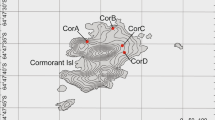Summary
Various environmental factors were investigated to analyse those involved in successful overwintering and possibly overwintering site selection for Tachyporus hypnorum and Demetrias atricapillus, both important coleopteran predators of cereal aphids. The results of the study indicated food supply to be important for both predator species during the winter period, although the role of biotic factors in site selection in the autumn could not be clearly demonstrated. The winter distribution of the two species could, however, be explained well in terms of abiotic factors. It is suggested that these and other similar predator species have well-defined overwintering requirements and that these can be exploited in the management of field boundary habitats.
Similar content being viewed by others
References
Andersen J (1985) Low thigmo-kinesis, a key mechanism in habitat selection by riparian Bembidion (Carabidae) species. Oikos 44:499–505
Bossenbroek PH, Kessler A, Liem ASN, Vlijm L (1977) The significance of plant growth-forms as “shelter” for terrestrial animals. J Zool Lond 182:1–6
Bryan KM, Wratten SD (1984) The responses of polyphagous predators to prey spatial heterogeneity: aggregation by carabid and staphylinid beetles to their cereal aphid prey. Ecol Entomol 9:251–259
den Boer PJ, den Boer-Daanje W (1990) On life history tactics in carabid beetles: are there only spring and autumn breeders? In: Stork NE (ed) The Role of Ground Beetles in Ecological and Environmental Studies Intercept Ltd, Andover, Hampshire, UK, pp 247–258
Chapman RF (1969) The Insects: Structure and Function. The English Universities Press Ltd, London, p 104
Chiverton PA (1989) The creation of within-field overwintering sites for natural enemies of cereal aphids. Brighton Crop Protection Conference — Weeds 3:1093–1096
Coombes DS (1987) Factors affecting the effectiveness of Demetrias atricapillus (L.) (Coleoptera: Carabidae) as a predator of cereal aphids. PhD thesis, Southampton University
Dennis P (1989) The predatory potential of staphylined beetles in cereals. PhD thesis, Southampton University
Dennis P, Wratten SD (1991a) Field manipulation of populations of individual staphylinid species in cereals and their impact on aphid populations. Ecol Entomol 16:17–24
Dennis P, Wratten SD (1991b) Mycophagy as a factor limiting aphid predation by staphylinid beetles (Coleoptera: Staphylinidae) in cereals. Bull Entomol Res 81:25–31
Desender K (1982) Ecological and faunal studies on Coleoptera in agricultural land II. Hibernation of Carabidae in agro-ecosystems. Pedobiologia 23:295–303
Grum L (1971) Remarks on the differentiation in Carabidae mobility. Ekol Pol 19:47–56
Lipkow E Von (1965) Biologisch-ökologische Untersuchungen über Tachyporus-Arten und Tachinus rufipes. Pedobiologia 6:140–177
Riedel W (1990) Hibernation sites for aphid-predators in cereals. 7th Danish Plant Protection Conference — Pests and Diseases, pp 249–259
Sotherton NW (1984) The distribution and abundance of predatory arthropods overwintering on farmland. Ann Appl Biol 105:423–429
Sotherton NW (1985) The distribution and abundance of predatory Coleoptera overwintering in field boundaries. Ann Appl Biol 106:17–21
Sunderland KD, Vickerman GP (1980) Aphid feeding by some polyphagous predators in relation to aphid density in cereal fields. J Appl Ecol 17:389–396
Sunderland KD, Crook NE, Stacey DL, Fuller BJ (1987) A study of feeding by polyphagous predators on cereal aphids using ELISA and gut dissection. J Appl Ecol 24:907–933
Thiele HU (1977) Carabid Beetles in their Environments: A Study on Habitat Selection by Adaptations in Physiology and Behaviour. (Zoophysiology and Ecology 10), Springer Berlin NY
Thomas MB, Wratten SD, Sotherton NW (1991a) Creation of “island” habitats in farmland to manipulate populations of beneficial arthropods: predator densities and emigration. Journal of Applied Ecology 28 (in press)
Thomas MB, Wratten SD, Sotherton NW (1991b) Creation of “island” habitats in farmland to manipulate populations of beneficial arthropods: successional changes in predator community structure. J Appl Ecol (in press)
Tukey JW (1949) One degree of freedom for non-additivity. Biometrics 5:232–242
Wallin H (1985) Spatial and temporal distribution of some abundant carabid beetles (Coleoptera: Carabidae) in cereal fields and adjacent habitats. Pedobiologia 28:19–34
Webster J (1959) Succession of fungi on decaying Cocksfoot culms. Part 2. J Ecol 44:517–544
Winder L (1990) Predation of the cereal aphid Sitobion avenae (F.) by polyphagous predators on the ground. Ecol Entomol 15:105–110
Author information
Authors and Affiliations
Rights and permissions
About this article
Cite this article
Thomas, M.B., Mitchell, H.J. & Wratten, S.D. Abiotic and biotic factors influencing the winter distribution of predatory insects. Oecologia 89, 78–84 (1992). https://doi.org/10.1007/BF00319018
Received:
Accepted:
Issue Date:
DOI: https://doi.org/10.1007/BF00319018




